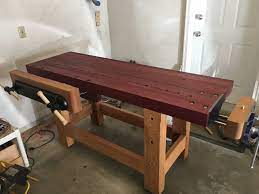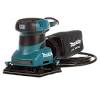I dont know if its my upbringing or some sort of deep-South formality that was transmitted to me via a Sonic cherry lime-aid, but I always wear a collard shirt when I work or travel.
It was probably my upbringing. Legend has it that my grandmother never wore a pair of pants a day in her life , only skirts.
So I was a little uncomfortable stripping down to a T-shirt today to demonstrate how to flatten a benchtop. It was so hot and humid out on Kelly Mehlers lawn, that I was happy to shave my head to cool down.
Even though I was uncomfortable, it was a great experience to give this demonstration on Friday afternoon. All the students have assembled and fitted their Holtzapffel-style workbenches. We will only need to install the twin-screw vices tomorrow, but most of that work is done.
Tomorrow, the eight students will each have a working workbench when they leave here. One workbench is already certified flat thanks to today’s planing demonstration.
The best thing about this class is the fact that each one is unique. The Holtzapffel design can accommodate a variety of vises. These vises could be old ones or Lie-Nielsen faces vises. Each of these benches is slightly different in height, length, and width to suit the maker’s needs.
And all of them look fantastic. We had seven of them on the lawn today, all of them turtle-backed on sawhorses as the students merrily installed their end vises in a notch cut into the top with just a handful of chisel chops (thanks to the Makita circular saw jig I brought along).
Despite the extensive joinery, the stubborn maple and the unconventional fastening methods (bolts & drawboring), all the students produced benches that can easily last hundreds of decades.
In fact, we joked about this a little bit before lunch. As we were hammering home some drawbore pegs, I noted that those pegs would be tight for several generations. One of the students remarked that after he died his bench would probably end up in somebodys high-end kitchen, or a plant stand in someones nursery or in an antique mall to hold a wide variety of ugly items for sale.
Although that may be true, if we make enough furniture for our benches, someone will take care of them. A bench is my personal safety net. My grandfathers bench is where I spent my summers with him, building nice things for his house (bookshelves with split-bamboo turnings) and junky stuff for me (a ring made from a silver quarter, stands for my model ships).
Handmade benches are one of the most personal pieces of your work that you can pass down. They are not only an expression of what you think is quality workmanship, but their passing to another is the passing of an obligation. Will your progeny use it to show off their wisterias? Or their workmanship?
I wonder about these eight benches and what the next 100 years holds for them. Of course, Im also still sweating on my keyboard hours after that planing demonstration, so Im also wondering if I should take off my T-shirt and drink a beer (also a result of my deep-South upbringing).



